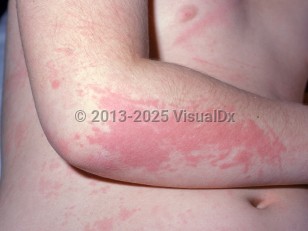The most widely adopted classification criteria for JIA are by the International League of Associations for Rheumatology (ILAR) and are for patients with symptom onset before age 16 years. Each category is mutually exclusive; patients who meet criteria for multiple categories are considered to have undifferentiated arthritis.
- Oligoarthritis (fewer than 5 joints involved) – The most common type of JIA, typically seen in girls aged 2-4 years, it usually affects the lower extremities. Criteria include duration of symptoms for 6 weeks or longer, affecting 1-4 joints over the first 6 months of disease. Patients cannot have a personal history of or first-degree relative with psoriasis, reactive arthritis, inflammatory bowel disease (IBD) (Crohn disease, ulcerative colitis) with sacroiliitis, or ankylosing spondylitis or features consistent with systemic-onset JIA. The patient cannot have a positive rheumatoid factor (RF) test. Males who have symptoms beginning after age 6 years who are human leukocyte antigen B27 (HLA-B27) positive are also excluded. This type of arthritis is often complicated by asymptomatic chronic anterior uveitis, a potentially sight-threatening condition; the presence of a positive antinuclear antibody (ANA) test increases this risk.
- Polyarticular JIA is characterized by arthritis lasting 6 weeks or longer affecting 5 or more joints during the first 6 months of disease. Patients can be further characterized as RF positive or RF negative. Patients cannot have a personal history of or a first-degree relative with psoriasis, ankylosing spondylitis, reactive arthritis, IBD with sacroiliitis, or acute anterior uveitis, and they cannot have features consistent with systemic JIA.
- Psoriatic arthritis – Often affects children aged 2-4 years and 9-11 years. It is diagnosed when arthritis symptoms last for 6 weeks or longer in a patient with concurrent psoriasis symptoms or in a patient with arthritis and 2 or more of the following: dactylitis (swelling of a finger), nail pits, or a first-degree family member with psoriasis. Patients cannot have a personal history of or a first-degree relative with ankylosing spondylitis, reactive arthritis, IBD with sacroiliitis, or acute anterior uveitis. Patients with nail, scalp, and inverse (intertriginous) psoriasis have a higher risk of developing psoriatic arthritis.
- Enthesitis-related arthritis – Usually affects boys aged older than 6 years and is diagnosed when arthritis and enthesitis (inflammation of the region where tendons and ligaments insert into bone) coexist for 6 weeks or longer. It is also diagnosed in patients with arthritis or enthesitis plus 2 of the following: HLA-B27 positive, acute anterior uveitis, presence or history of sacroiliac tenderness and/or inflammatory back pain, or onset of arthritis in a male aged 6 years or older. Patients cannot have a personal history of or a first-degree relative with psoriasis, must be RF negative, and cannot have features consistent with systemic JIA. The Achilles tendon and plantar fascia are the most common sites of enthesitis. This is often called seronegative spondyloarthropathy.
- Systemic arthritis – This disorder is characterized by the presence of arthritis for 2 weeks or more with quotidian fevers (usually occurring at night) plus 1 or more of the following: an evanescent salmon-colored rash, hepatosplenomegaly, generalized lymphadenopathy, or serositis. Patients may not have a personal history of or first-degree relative with psoriasis, ankylosing spondylitis, reactive arthritis, IBD with sacroiliitis, acute anterior uveitis, onset of arthritis in a male aged 6 years or older who is HLA-B27 positive, or a positive RF test. Many patients will have a leukocytosis and elevations in inflammatory markers (ESR, C-reactive protein [CRP]). Not all features of the disorder will be present at disease onset. It most often occurs in children aged younger than 5 years. This disorder is thought to represent an autoinflammatory disease in which the innate immune system creates uncontrolled systemic inflammation. The development of macrophage activation syndrome can be fatal.
- Undifferentiated arthritis – Patients with arthritis symptoms for 6 weeks or longer who do not meet inclusion criteria for any of the above diseases or who meet more than 1 set of criteria are classified in this category.



 Patient Information for
Patient Information for 
